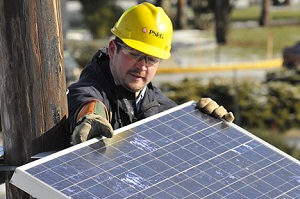Some residents in New Jersey upset over utility pole solar projects
 New Jersey’s Public Service Electric and Gas Co. (PSE&G) is installing 40 megawatts of distributed generation on utility poles across its service area, which covers about three-quarters of the state. Thus far it’s installed about 90,000 PV modules, producing 19 megawatts of solar power, on utility poles in 150 towns, with mainly positive results.
New Jersey’s Public Service Electric and Gas Co. (PSE&G) is installing 40 megawatts of distributed generation on utility poles across its service area, which covers about three-quarters of the state. Thus far it’s installed about 90,000 PV modules, producing 19 megawatts of solar power, on utility poles in 150 towns, with mainly positive results.
But more recently, as it has started to install the grid-tied solar panels in affluent towns, the company has run into some NIMBY (not in my back yard) friction.
The utility is installing solar modules as part of its Solar 4 All project, which totals 80 megawatts of solar throughout the state. The utility poles consist of half of the project. The other half will consist of centralized solar generation, according to the company.
Some residents in the towns of Oradell, Wyckoff and Ridgewood, N.J., have complained about the installations, telling The New York Times that the modules are hideous.
“I hate them. It’s just an eyesore,” Eric Olsen, a resident of Oradell, told the newspaper.
The residents have raised complaints about the look of the modules and have questioned the effect that they will have on their home values, among other things.
“This is the most vocal outcry that we’ve heard to date. A lot of the complaints from the towns come down to their complaints about aesthetics,” said PSE&G spokesperson Fran Sullivan. “If you look at the comments on a lot of these articles online—really it’s a vocal minority that’s against the panels. A lot of comments we’ve seen are supportive. The New York Times had about 300 comments online, the vast majority of them are supportive.”
Offended residents also said they weren’t warned that the panels were coming. But Sullivan said that’s not the case.
“We notify town leadership a few weeks ahead of time, We’ve found the best way is to issue a press release to the local papers. We have been giving people notice as we move through the state and will continue to do so,” he said.
When PSE&G has run into a problem, like in these towns, the company will stop installing the modules until they’ve met with town leadership and the residents to explain what the company is doing, how safe the panels are and addressed other issues raised by locals.
“If you live in New Jersey, you kind of realize these are a few towns. This has been just one small period over a year of putting in 90,000 modules,” Sullivan said.
Image courtesy of PSE&G.



